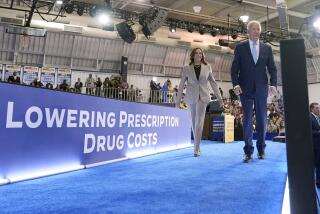How a hugely overpriced hepatitis drug helped drive up U.S. health spending
There’s one especially eye-catching number in a new report by Medicare actuaries about U.S. healthcare spending: 12.6%.
That’s the leap in prescription drug spending last year over the year before. How sharp an increase is it? It was five times as much as the increase for 2013 over 2012, which was a mere 2.5%.
The actuaries have no doubt what’s driving the increase. It’s “a result of expensive new treatments for hepatitis C,” they write in their report for the journal Health Affairs. And more than any other drugs, that means Gilead Science’s Sovaldi, which cost about $84,000 for a 12-week treatment, or about $1,000 per once-a-day pill.
The increase in prescription costs was a sizable contributor to an increase in U.S. healthcare spending growth last year of 5.5%, a spike up from the previous year’s increase of 3.6% and the first time growth exceeded 5% since 2007; if not for the drug spending, the overall increase would have been only 4.8%.
But the major driver, the actuaries reported, was the expansion of healthcare coverage under the Affordable Care Act, which brought new insurance coverage to 8.4 million Americans. That expanded coverage had clear benefits to the newly insured: the nationwide growth in out-of-pocket spending slowed to just 1.3% last year from 3.2% in 2013, because so much more healthcare was covered by health plans or Medicaid.
The major cloud on spending patterns was drug pricing. As we reported in June, Sovaldi and its follow-on drug Harvoni are the closest thing in years to miracle drugs. Their cure rate of hepatitis C, a condition that can lead to liver failure or liver cancer, exceeds 90%, with almost none of the horrific side effects caused by their predecessor treatments.
Those side effects had kept many with hepatitis C, which progresses slowly and often invisibly, from seeking treatment. But the new drugs’ arrival brought thousands of patients out of the woodwork; new patients leaped from 17,000 in 2013 to 161,000 last year.
The caseload and the cost stunned commercial insurers and public programs such as Medicare and Medicaid alike; many refused to cover the new drugs except for patients with advanced liver disease. That defeated the purpose of the drugs, which would prevent those advanced, costly-to-treat conditions from developing in the first place. But even with those restrictions, the drugs drove prescription drug spending through the roof.
That’s bound to intensify questions over why Sovaldi and Harvoni are so expensive for U.S. patients. Gilead’s profit margins on the drugs are stupendous. In the first half of this year, it recorded profit of $8.8 billion on $15.3 billion in sales, a net profit margin of nearly 58%. For the full year, the company projects gross profit margins of up to 90%.
After the release of its second-quarter financial results Tuesday, Gilead’s executive vice president of commercial operations, Paul Carter, groused that “there still are a lot of (payer) restrictions in place in the U.S.,” according to the San Francisco Business Times. But although Gilead has offered discounts to some payers in return for more liberal patient approvals, the company plainly has pursued a calculated strategy that the success of its drugs will force insurers to pay for them at a large fraction of the list price.
Gilead has taken enormous heat for its pricing strategy. Its list price for Sovaldi is more than twice the $36,000 the drug’s original developer, Pharmasset, had planned to charge before that company was acquired by Gilead in 2011 for $11 billion. It was also vastly out of line with Pharmasset’s research and development costs, which the Senate Finance Committee has estimated at less than $63 million in 2009-11. One pharmacy management executive has termed the pricing an act of “unmitigated gall.”
As we observed last month, Gilead’s ability to charge what the U.S. market will bear reflects a broken, overly indulgent, drug pricing regime in the U.S. In Canada and Britain, which don’t allow unfettered drug pricing, the cost of a full Sovaldi treatment is $55,000. In Egypt, it’s only $900.
The new report by the actuaries of the government’s Centers for Medicare and Medicaid Services, suggests that pressure on Gilead and other manufacturers of high-priced drugs may force prices down. The actuaries project that rebates for the hepatitis C drugs will cut Medicare spending growth for prescriptions to 9% this year from 17.3% in 2014. That’s good news, but it’s only a reminder that the price in 2014 reflected not merely profit, but profiteering.
Keep up to date with the Economy Hub. Follow @hiltzikm on Twitter, see our Facebook page, or email [email protected].
More to Read
Inside the business of entertainment
The Wide Shot brings you news, analysis and insights on everything from streaming wars to production — and what it all means for the future.
You may occasionally receive promotional content from the Los Angeles Times.











